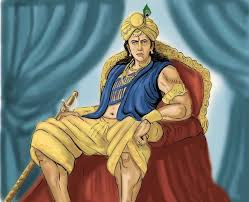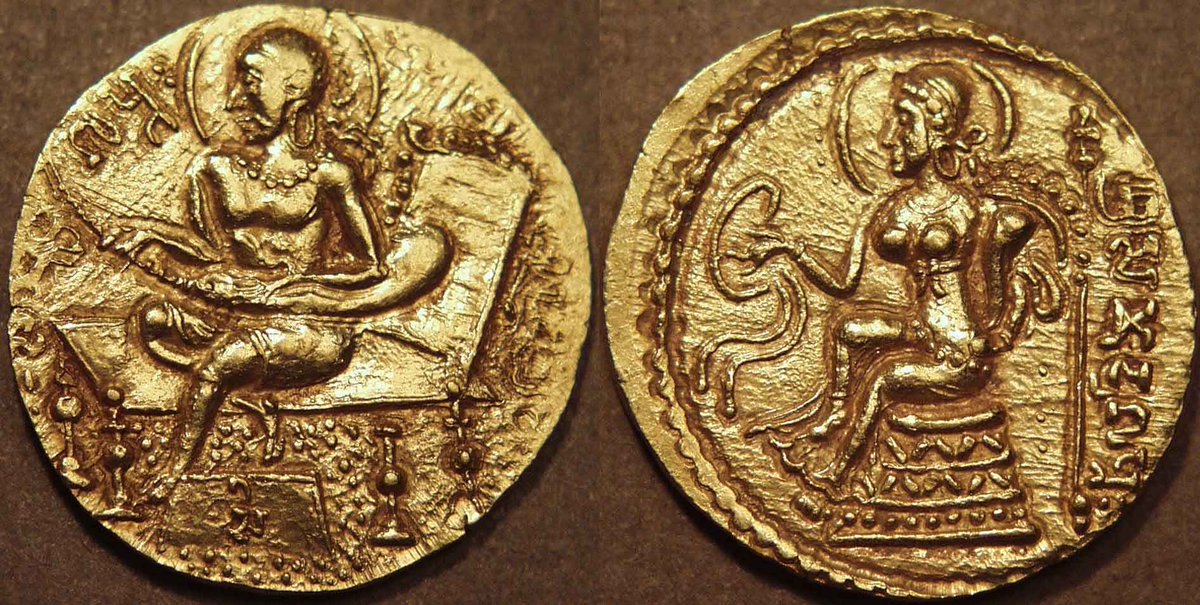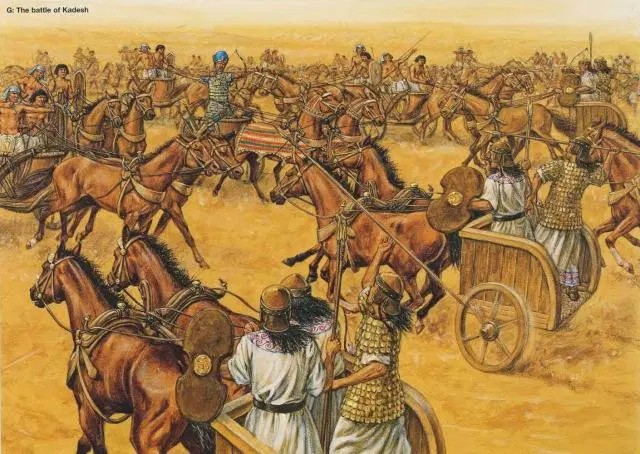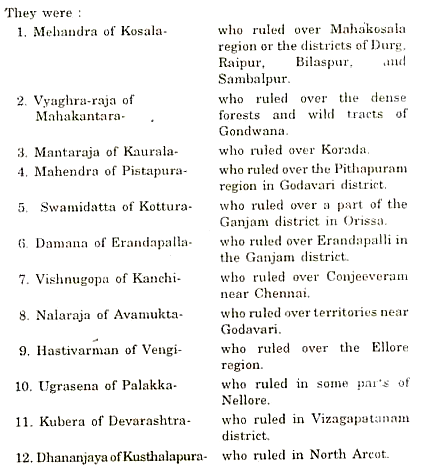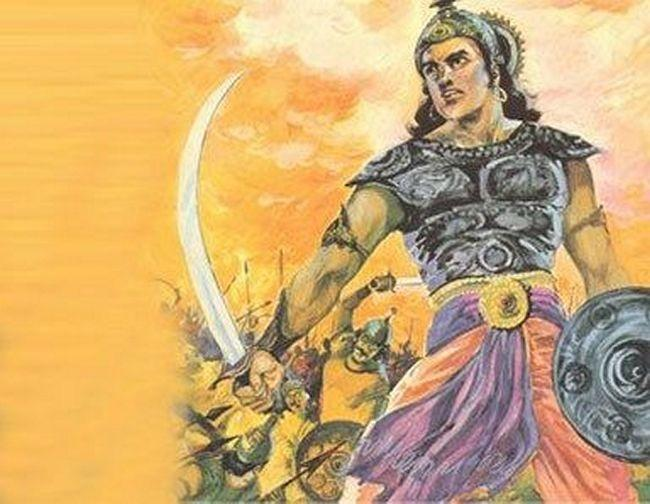Thread on "Samudragupta"
Samudragupta, ruler of the Gupta Empire (c. 335 – c. 375 CE), is considered to be one of the greatest military geniuses in Indian history. He was the third ruler of the Gupta Dynasty, who ushered in the Golden Age of India.
Samudragupta, ruler of the Gupta Empire (c. 335 – c. 375 CE), is considered to be one of the greatest military geniuses in Indian history. He was the third ruler of the Gupta Dynasty, who ushered in the Golden Age of India.
he was preceded by Kachagupta or Kacha who was Chandragupta I’s eldest son.
Chandragupta I actually nominated Samudragupta to the throne shows that he was not his eldest son.
Chandragupta I actually nominated Samudragupta to the throne shows that he was not his eldest son.
Chandragupta could only nominate his younger son based on his abilities but was not able to actually make him king.
The decision of the king was publicly announced in an open assembly of the king’s counselors who accepted the selection with joyous satisfaction.
The decision of the king was publicly announced in an open assembly of the king’s counselors who accepted the selection with joyous satisfaction.
After announcing the succession in favour of Samudragupta, his father instructed the prince: “Protect ye this earth”.
From the above statement of the Allahabad pillar Inscription, some scholars concluded that there were others sons of Chandragupta I who aspired to the throne.
From the above statement of the Allahabad pillar Inscription, some scholars concluded that there were others sons of Chandragupta I who aspired to the throne.
Samudragupta succeeded his father in the year 335 A.D., and ruled for long forty years till 375 A.D. He amply justified his father’s selection by proving himself a great conqueror and a mighty monarch.
He took pride in the fact that he was the son of Kumaradevi, and claimed himself as the Lichchhavi-Dauhitra or the son of the daughter of the Lichchhavis. His title of Parakramanka indicates his power.
He has been described by some as the Chakravartin of the Ganga Valley, and a Digvijayi of other countries. The Eran Inscription states that “the whole tribe of kings upon the earth was overthrown and reduced to the loss of the wealth of their sovereignty” by Samudragupta.
The British historian Vincent Smith (1848 – 1920 CE) was the first to dub him as & #39;the Indian Napoleon& #39;. His many conquests have been alluded to in the Allahabad pillar inscription, composed by a high-ranking official named Harishena, who was also a skilled author and poet.
Harishena was in full knowledge of Samudragupta’s achievements as a warrior. He described those achievements in a chronological order of events as they actually occurred.
Samudragupta adopted strategic plans m his invasions of the north and the south. He decided to subdue the neighbouring kingdoms first, before taking up distant expeditions.
he attacked the ruler of the upper Ganga valley and destroyed many other kings, notably Rudradeva, Matila, Nagadatta, Chandravarman, Ganapatinaga, Nagasena, Achyuta, Nandin and Balavarman.
His invasions show three distinct phases, namely, his first campaign in Aryavarta, his campaigns in Dakshinapatha, and his second campaign in Aryavarta.
Samudragupta also effected the conquest of the Atavika or forest kingdoms.
Samudragupta also effected the conquest of the Atavika or forest kingdoms.
He also established diplomatic relations with the states situated on the frontiers of the Gupta Empire. And, finally, he exchanged political negotiations with the distant foreign powers.
For some kings, it was considered sufficient if they paid tribute and gave obeisance to the Gupta emperor.
These kings were ruling the areas of Samatata (present-day Bengal state), Devaka and Kamarupa (present-day Assam state), Nepal and Kartripura
These kings were ruling the areas of Samatata (present-day Bengal state), Devaka and Kamarupa (present-day Assam state), Nepal and Kartripura
The chiefs of various republics too were added to this list of kings. These republics included those of the Malavas, Arjunayanas, Yaudheyas, Madrakas, Abhiras, Prarjunas, Sanakanikas, Kakas and Kharaparikas.
After his victory over the three northern powers, Samudragupta took up his expedition in the Deccan. In course of his southern campaigns he humbled as many as twelve princes.
Samudragupta’s strategy was guided by the prevailing political and economic conditions. He realized that he could not control directly a vast empire from his capital and hence focused on annexing those kingdoms which lay on his borders.
For the rest, only an acceptance of suzerainty was needed while their own kings would be left to deal with issues of governance and administration. At the same time, being subordinate, they would not create challenges for the Guptas.
In the north he played the part of a digvijayi or “conqueror of the quarters,” of the Early Magadhan type. But in the south he followed the Epic and Kautilyan ideal of a dharmavijayi or “righteous conqueror,”
-- He may have realised the futility of attempting to maintain effective control over these distant regions in the south from his remote base in the north-east of India.
The victory of Samudragupta in his Aryavarta wars gave to the Gupta Empire its proper shape as an all comprehensive northern empire.
By his conquests of the lands of nine north India kings, Samudragupta more or less became the master of a larger portion of the proper Aryavarta.
By his conquests of the lands of nine north India kings, Samudragupta more or less became the master of a larger portion of the proper Aryavarta.
The Gupta Emperor thereafter wanted to establish his hegemony even over the inaccessible forest kingdoms ruled by the tribal chiefs. Their chiefs were reduced to the condition of being serfs or Puricharika of the supreme ruler.
The Gupta empire under Samudragupta did not directly control many of the constituents of the empire. Samudragupta, thus, despite his conquests, did not create an all-India empire.
Using his military power, he instead built up the political machinery in such a way that the Gupta suzerainty and paramountcy came to be acknowledged over most of the subcontinent and many kingdoms and republics regarded themselves as subordinate to the Gupta emperor.
At his succession, Samudragupta seems to have possessed an empire that included Magadha and its adjoining areas from the present-day states of Uttar Pradesh and Bengal. In the north, the boundaries of this empire stretched to the Himalayan foothills.
The borders of the Gupta Empire were ringed by kingdoms which were subordinated to Gupta rule and recognized its primacy. The king of Sri Lanka and the Kushana and Scythian kings acknowledged his suzerainty.
Samudragupta and the princes were supposed to be matchless warriors themselves, like his son prince Chandragupta II.
Samudragupta took a personal interest in all his wars and campaigns which were not left to the discretion of his ministers and generals.
Samudragupta took a personal interest in all his wars and campaigns which were not left to the discretion of his ministers and generals.
he was a fearless fighter who had fought a hundred battles (samarashata) which left on his body their scars (vrana) as marks of decoration (shobha) and glowing beauty (kanti), caused by different kinds of weapons of war.
He was a great musician and played the vina, an Indian stringed instrument resembling the lyre or lute, with great aplomb. He was a highly intellectual person and an accomplished poet.

 Read on Twitter
Read on Twitter